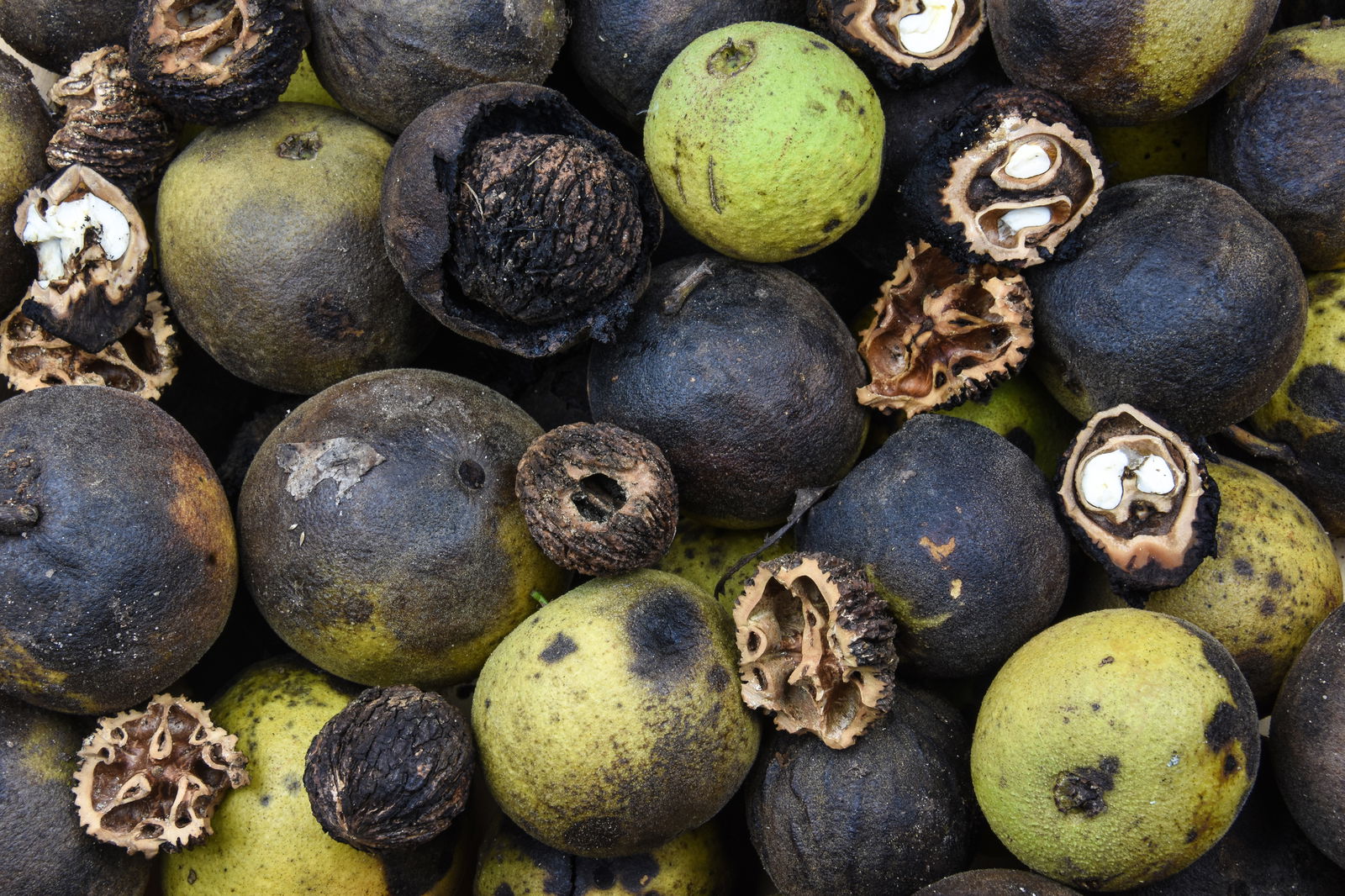Lower your grocery bill this winter by foraging for these wild edibles

By Wealth of Geeks
With food prices rising 15% between October 2021 and October 2023, finding ways to lower your grocery bill can dramatically affect your budget. Foraging is a brilliant way to supplement your stores. You get free food, it’s a fun family activity, and it gets you exercising and out in nature.
It’s true that foraging in winter is not as easy as in late summer, when the trees and bushes are heavy with beautifully ripe fruit and nuts, and you’re surrounded by lush edible greens. But if you know what to look for, you can find plenty of wild food to help reduce your grocery bill, even in the depths of winter.
The USDA’s nutritious food plan for a family of four, including two children under 11, with a modest budget is $1,306.30 per month. Incorporating techniques like foraging and figuring out how to make your food last longer can reduce your food budget by 10%.
Hop hornbeam seeds
Hop Hornbeam seeds have a nutty flavor. You can gather them and use them like grains or nuts in your cooking. They’re perfect for adding to bread or using as a cereal grain. You can also toast them lightly to enhance their flavor and add them to salads or homemade granola for a crunchy texture.
Black walnuts
Black walnuts have a rich, distinctive flavor that’s stronger than regular walnuts. You’ll see these nuts in late fall, and if the birds and squirrels don’t get there first, you can find them into the winter months, too.
Crack their tough shells to reveal the nut, which is excellent for baking or snacks. Harvesting and preparing black walnuts is labor-intensive, but their robust flavor makes them well worth the effort.
Dock seeds
The seeds of the dock plant are easy to collect all winter. They have a slightly bitter taste and work well in soups and stews. You can also grind them into flour for baking.
Dock seeds are a good source of fiber and add a rustic, earthy element to your dishes. You can also sprout them for a nutritious addition to salads.
Beechnuts
Beechnuts, from the American beech tree, are small but flavorful. You can eat them raw or roasted. They have a sweet, light taste. Like walnuts, if the wildlife doesn’t get to them first, you’ll find fallen beechnuts throughout the winter, especially if they get covered by snow.
Beechnuts are high in fat and protein, making them a nourishing snack during the colder months. Add them to trail mix or granola, use in pesto, or grind into flour for baking.
Pine nuts
Pine nuts are a delightful find in winter. Beyond their use in Mediterranean cuisine, these nuts are particularly tasty when toasted, bringing out a rich, buttery flavor that enhances salads, pestos, and pasta. Pine nuts are also a great energy source and contain healthy fats, making them an excellent addition to your winter diet.
Just be aware that not all pine trees produce edible nuts and needles, so do your research and only harvest from edible varieties.
Goosefoot seeds
Goosefoot, or wild quinoa, provides nutritious seeds that are a fantastic wild alternative to (often overpriced) cultivated quinoa. These seeds contain a lot of protein, and you can use them like regular quinoa in stews, grain bowls, wraps, and more.
I like goosefoot or quinoa “popped” with some oil like popcorn, then coated in honey and lightly baked into clusters. They make a lovely movie night snack alongside or instead of regular popcorn.
Crabapples
Crabapples, despite their tartness, are a versatile and valuable winter-foraging fruit. You can transform them into delicious jellies and syrups and add them to desserts for a tangy and flavorful twist. Crabapples are also rich in pectin, making them excellent for thickening sauces and jams. Their bright, acidic flavor is a welcome addition to savory dishes, such as chutneys or braised meat dishes.
Many varieties of crab apples hang on the branches well into winter, getting sweeter as time goes on. I make sure to keep plenty of blackberries in the freezer, and then, in winter, when the crab apples are wonderfully sweet and full of pectin, I harvest them, get the blackberries out of the freezer, and make my favorite no-sugar blackberry jam.
Rosehips
Rosehips, the fruit of the rose plant, are one of my winter foraging favorites due to their high vitamin C content. Wait until after the first frost, as rosehips get sweeter after a freeze.
I love to make rosehip jam and jelly, but I also add them to my festive rum, tincture them, and include them in teas and syrups. You can also dry them to use in herbal tea blends.
Hawthorn berries
Hawthorn berries are edible and medicinal, particularly for heart health. I forage hawthorn berries every year and make a potent tincture from them. I also really like hawthorn jam. I dry them for herbal teas and make an immune-boosting syrup from hawthorn, rosehips, elderberries, and even ketchup. You can also bake with them, creating tarts, sponges, and other tasty pastries.
Cranberries
Wild cranberries, with their tart and vibrant flavor, are perfect for foraging in late fall to early winter, particularly in boggy or marshy areas. You may even find some surviving through the winter beneath the snow.
Daisy greens
Daisy greens, often overlooked, are a nutritious and edible wintergreen. They taste slightly bitter, similar to other leafy greens, and go well in winter salads. You can also cook them similarly to spinach and add to stir fries and other warm dishes. Rich in vitamins and minerals, daisy greens are a welcome and nutritious addition to your winter diet.
Dandelions
Dandelions are a gift of nature, with their leaves, roots, and flowers all edible. In winter, dandelion leaves have a milder flavor. I add dandelion greens to salads and wilt or sauté them like spinach.
Dandelion isn’t a weed. It contains many vitamins and micronutrients and has a long history as a medicinal and food plant. As a herbalist, I also use dandelion preparations for kidney function, liver and gallbladder detox and support, and to aid digestion. It’s also a potent diuretic.
And you can roast and use the roots as a coffee substitute in times of scarcity.
Nettles
Nettles are a winter foraging favorite, especially in milder climates. Rich in vitamins and minerals, they offer a nutritional boost to any meal. To safely enjoy nettles, cook them first to remove the sting, then use them like any other tender greens. Nettles are excellent in soups, stews, or as steamed greens. Their deep, earthy flavor makes them a popular ingredient for hearty winter dishes.
Watercress
Watercress, thriving near streams and rivers, makes a fresh, peppery addition to your winter foraging. Often found year-round, watercress is high in nutrients and adds a zesty flavor to salads, sandwiches, and soups.
Its crisp texture and spicy taste make it an excellent green for adding a fresh note to winter meals. Watercress is flavorful and packed with antioxidants, making it a healthy choice during the colder months.
Chickweed
Chickweed, a hardy and resilient winter plant, grows just about anywhere. It’s a versatile herb that is great when eaten raw in salads, with its mild flavor. It’s rich in vitamins and minerals and cooks up just like spinach.
Miner’s lettuce
Miner’s lettuce, or winter purslane, is a tough little plant that can withstand bad winters. It has a slightly succulent, tangy-sweet flavor and gives salads a lovely, bright freshness. It’s high in vitamin C, too.
Winter purslane makes a beautiful pesto, and you can use it anywhere you’d typically use spinach.
Burdock roots
Burdock roots have a sweet and earthy flavor. You can dig these up and use them as you would artichokes. For best results, peel and soak them to reduce any bitterness. You can also pickle them.
Chicory root
With its robust, earthy flavor, Chicory root is widely known as a caffeine-free coffee substitute when roasted and ground. You can also add it to dishes for a touch of bitterness, as you would radicchio or endive. It’s also rich in inulin, a prebiotic fiber, making it beneficial for digestive health.
Jerusalem artichoke
Jerusalem artichokes, or sunchokes, are tubers you can harvest throughout the winter. These versatile vegetables offer a nutty, sweet flavor. Roast them for a caramelized treat, boil and mash for a creamy side dish, or slice raw into salads for a crisp texture. Jerusalem artichokes are tasty and a great source of iron and potassium.
Yellowfoot chanterelle
In damp, wooded areas, you’ll find yellowfoot chanterelles, a winter delight for mushroom foragers. These mushrooms have a delicate, slightly fruity flavor and a tender texture. They are excellent sautéed in butter or olive oil and make a delicious addition to soups, stews, and risottos. You can also pickle yellowfoot chanterelles or dry them for later use.
Oyster mushrooms
Oyster mushrooms are one of the more accessible and delicious fungi to forage during winter. They often grow on the sides of trees, and their oyster-shaped caps make them easy to identify. These mushrooms have a delicate, slightly sweet flavor and a velvety texture. They are fantastic sautéed, and you can use them in various dishes, from stir-fries to creamy pasta sauces. Oyster mushrooms are tasty and a great source of protein and vitamins.
A word of caution
Whether it’s mushrooms, berries, or greens, only forage plants you are confident in identifying. Consuming an unidentified or misidentified wild plant or fungi is dangerous. Eating the wrong thing can make you incredibly sick and, in some cases, can be lethal.
If you want to be extra safe, get an identification book and a place on a local foraging course. Or find a local forager willing to take you out and share their knowledge with you. Supplementing your income or food stores is smart, but doing so safely is essential.
Be an ethical forager
Don’t take more than you need, or more than a third from any one place. As a general rule of thumb, grab a third for yourself, leave a third for the local wildlife and a third to repopulate. Some plants and fungi are being over-foraged to the brink of local extinction, so please, don’t be greedy.



